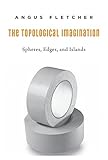The topological imagination : spheres, edges, and islands / Angus Fletcher.
Material type: TextPublisher: Cambridge, Massachusetts : Harvard University Press, 2016Description: 215 pages : illustrations ; 25 cmContent type: text Media type: unmediated Carrier type: volumeISBN: 9780674504561; 0674504569Subject(s): Topology | Mathematics -- Philosophy | Art and science | Knowledge, Theory of | Art and science | Knowledge, Theory of | Mathematics -- Philosophy | Topology | Imagination | Topologie | Kreativität | Sprache | PhilosophieDDC classification: 514 LOC classification: QA611 | .F495 2016
TextPublisher: Cambridge, Massachusetts : Harvard University Press, 2016Description: 215 pages : illustrations ; 25 cmContent type: text Media type: unmediated Carrier type: volumeISBN: 9780674504561; 0674504569Subject(s): Topology | Mathematics -- Philosophy | Art and science | Knowledge, Theory of | Art and science | Knowledge, Theory of | Mathematics -- Philosophy | Topology | Imagination | Topologie | Kreativität | Sprache | PhilosophieDDC classification: 514 LOC classification: QA611 | .F495 2016| Item type | Current library | Call number | Copy number | Status | Notes | Date due | Barcode |
|---|---|---|---|---|---|---|---|
 Books
Books
|
Female Library | QA611 .F495 2016 (Browse shelf (Opens below)) | 1 | Available | STACKS | 51952000343042 | |
 Books
Books
|
Main Library | QA611 .F495 2016 (Browse shelf (Opens below)) | 1 | Available | STACKS | 51952000343059 |
Browsing Female Library shelves Close shelf browser

|

|

|

|

|

|

|
||
| QA611 .A68 1983 Basic topology / | QA611 .D38 2005 Topology / | QA611 .E534 2008 Elementary topology : problem textbook / | QA611 .F495 2016 The topological imagination : spheres, edges, and islands / | QA611 .G35 1999 Introduction to topology / | QA611 .J3513 1984 Topology / | QA611 .K4 1975 General topology / |
Includes bibliographical references and index.
Topology and the idea of form -- The mind imagining -- Disparities in metaphor -- Euler discovers the first edge -- Vico and the cycles of human history -- The round earth's imagined corners -- Notes on a family of edges -- Shape and the ethics of scale -- No man is an island.
"Ordinary speech and the mathematical language of numbers appear to be light years apart, but this book counters that belief. The author joins two commonly separated domains of human creativity--the emotionally charged poetic imagination and the cool mathematical science of topology, which envisions how shapes change when objects are bent, twisted, or stretched without losing an invariant contact with their original forms. For topology, donuts and coffee mugs are "the same," like musical variations on a persistent theme. Nine concise chapters indicate how such twin powers create a concern with value. Poetry, philosophy, fiction, and history all use metaphors to stretch our ability to interpret, their freedom derived from stressing metaphoric disparity, while topology strictly treats quality rather than measurement and quantity. Shakespearean speeches echo throughout this book, for their variations on quality mark discoveries by the great mathematician Leonhard Euler. In solving an old riddle, The Bridges of Königsberg, and through his Polyhedron Theorem, he demonstrated how shape could preserve "permanence in change," like an aging though familiar human face. Current global concerns involve the connection between words, metaphors, mathematics, and transformational powers, among them our world climate; our oddly edgeless planet being structured by edges; theory of cyclical history reflecting biology; the Königsberg Bridges solution, describing networks and hence our modern algorithmic computation; the circulatory patterns of life in our biosphere; the spherical aspect of human time; the ethics derived from equitable scales; the significant topology of islands and their role in evolutionary theory and the human imagination."-- Provided by publisher.
1 2

There are no comments on this title.